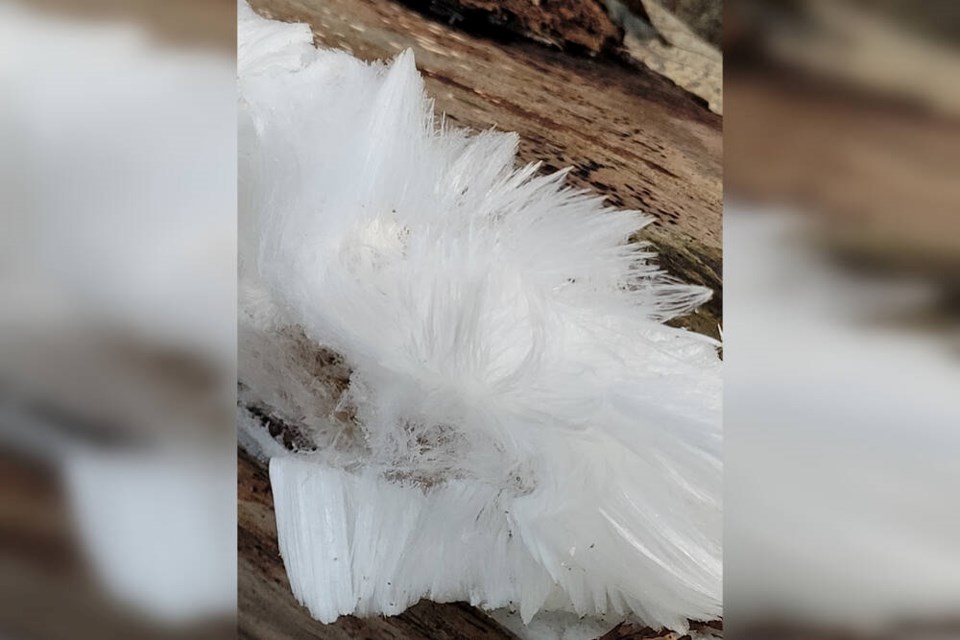Gitta Oldendorff has been running through these woods for 20 years and had never seen it before.
On Monday, on the Pipeline Trail in Capilano River Regional Park, off Fonteyn Way in North Vancouver, she eyed what she first thought was dog hair that had been rubbed off. On closer inspection, she saw that the whimsical white whiskers were something else entirely.
It was captivating because of the whiteness and the almost fairy-like nature of the hairs, Oldendorff said. “[There was] something magical about it, and immediately to me felt like a very special phenomenon that I was privileged to see.”
The formations that she witnessed are known as hair ice – also called frost beard or ice wool. It’s usually seen on pieces of dead broadleaf wood, like the specimens that Oldendorff found.
She wasn’t sure, but Oldendorff speculated it could have been alder, which grows throughout southwestern regions of B.C.
While a rare sighting for some, they can be spotted fairly often if you know when to look.
“Usually it arises after it pours rain, and then you have a cold snap,” said Tricia Edgar, education programmer at Lynn Canyon Ecology Centre. That’s exactly what happened earlier this week.
“Then the water gets pushed out of the pores in sticks and logs and becomes these hair-like filaments,” she said. “It’s really interesting.”
Places like Lower Seymour and Lynn Canyon are good places to look because they’re lush in deciduous trees. To Edgar’s knowledge of the phenomenon, the fungus creates an antifreeze property that prevents the ice from chunking up like it normally would.
“Lots of things in nature have antifreeze in them, like bugs … because that prevents them from freezing in the winter,” she said.
Hair ice usually disappears when the sun shows up, but can stick around for hours if it stays cool, Edgar added.
Combing through the history and science of hair ice
When Alfred Wegener – founder of the theory of continental drift – first described hair ice in 1918, he observed that the filaments only grew on branches with thin threads of mycelium belonging to a fungus.
A little while later, in 2015, German and Swiss researchers identified the white crustose fungus Exidiopsis effusa as responsible for the formation of hair ice. According to their research, liquid near the branch surface creates a thin layer of ice, sandwiching the water beneath it between the ice and pores of the wood. That creates a suction force, which pushes water from inside the wood to the ice at the surface, where it freezes and adds to the existing ice.
As the process continues, the ice builds up into fine strands. A key role of the fungus, the researchers said, is creating the antifreeze effect that stops crystals from growing too large and bunching up. Without the fungus, the ice forms as an icy crust rather than wispy hairs.
While this explanation is accepted by many mycologists, some fungus fanatics say the theory is dubious.
Adolf Ceska, now retired, was formerly the botany curator at Royal BC Museum and a rare vegetation expert at the B.C. Conservation Data Centre.
Because of Gibbs Phase Rule of thermodynamics, Ceska said it’s unlikely that liquid water is involved in forming hair ice.
He also said that the research is shaky on how the ice starts to form.
“If you want to get a large crystal of something, you put a thread in the concentrated solution and the crystals start to form on that thread,” Ceska said. “The assumption for hair ice is that the spores of the mushrooms are the initial nuclei on which the hair ice start to build up.”
So the question is: where does the hair ice start to form? It could be the spore of the mushroom or the surface of the branch, but Ceska said that still needs be found out.
“We have a collection of similar species in Royal Roads [university at Hatley Park on Vancouver Island]. I wouldn’t expect any crystallization on our species because it’s a slimy, glutinous surface. It needs to be powdery or something like that.”
Next time you see some hair ice, Ceska is asking that you cut off the branch, mark the area that had the ice, let it dry and send it to him. The career plant ecologist said he has the literature and experience to see what fungal elements are involved.





